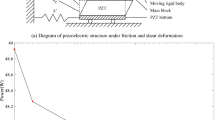Abstract
The electric response and processes occurring in piezoelectric elements subjected to pulsed pressure are usually described for two extreme cases: when the time of pressure variation is much longer than the time of propagation of an acoustic wave through a piezoelectric element, when the pressure in the piezoelectric element can be treated as constant (thin sensor regime), and under loading by a rectangular shock wave, when the shock front divides the piezoelectric element into the compressed and uncompressed zones (thick sensor regime). In the former case, the voltage across the piezoelectric element and electric fields emerging in it directly depend on the electric load, and the induced charge is proportional to the applied pressure (in the linear region). In the latter case, the current generated by the piezoelectric element is proportional to the shock load pressure, and the fields in the bulk of the piezoelectric element appear even in the case of short-circuiting of its electrodes. In this study, we consider the electric response of piezoelectrics to the action of pressure, which noticeably varies during the time commensurate with the time of propagation of the shock wave through the piezoelectric element. Such a situation takes place, for example, when a high-velocity particle flow formed when the shock wave emerging on the free surface of the metal plate (dusting) [1–4] is incident on the piezoelectric sensor. The calculations based on the constructed mathematical model show that under an increasing pressure on the piezoelectric element, electric fields with magnitudes depending on the rate of pressure increase and nonuniform over the piezoelectric element thickness appear in its bulk, and the induced electric charge is proportional to the average pressure in the piezoelectric element. Under certain conditions, these fields can attain values leading to the emergence of breakdown in the piezoelectric element and to distortion of generated signals. We consider experimentally observed cases of manifestation of breakdown effects under the action of rapidly increasing pressures in piezoelectric elements.







Similar content being viewed by others
REFERENCES
J. M. Walsh, R. G. Shreffler, and F. J. Willing, J. Appl. Phys. 24, 349 (1953).
V. A. Ogorodnikov, A. G. Ivanov, A. L. Mikhailov, N. I. Kryukov, A. P. Tolochko, and V. A. Golubev, Fiz. Goreniya Vzryva 34, 103 (1998).
A. L. Mikhailov, V. A. Ogorodnikov, V. S. Sasik, V. A. Raevskii, A. I. Lebedev, D. E. Zotov, S. V. Erunov, M. A. Syrunin, V. D. Sadunov, N. V. Nevmerzhitskii, S. A. Lobastov, V. V. Burtsev, A. V. Mishanov, E. V. Kulakov, A. V. Satarova, et al., J. Exp. Theor. Phys. 118, 785 (2014).
V. A. Ogorodnikov, A. L. Mikhailov, S. V. Erunov, M. V. Antipov, A. V. Fedorov, M. A. Syrunin, E. V. Kulakov, O. A. Kleshchevnikov, I. V. Yurtov, A. A. Utenkov, S. A. Finyushin, E. A. Chudakov, D. A. Kalashnikov, A. S. Pupkov, A. V. Chapaev, et al., J. Exp. Theor. Phys. 125, 985 (2017).
M. V. Antipov, A. A. Utenkov, I. V. Yurtov, I. V. Yurtov, A. A. Utenkov, A. V. Blinov, V. D. Sadunov, T. V. Trishchenko, V. A. Ogorodnikov, A. L. Mikhailov, V. V. Glushikhin, and E. D. Vishnevetskii, Combust. Explos., Shock Waves 54, 599 (2018).
A. N. Razin, Modeling Instability of Turbulent Mixing in Layered Systems (RFYaTs-VNIIEF, Sarov, 2010) [in Russian].
GOST (State Standard) 11 0444-87, Piezoceramic materials, specifications.
R. A. Graham, Solids Under High-Pressure Shock Compression, Mechanicals, Physics, and Chemistry (Springer, New York, 1993).
V. I. Yarovikov, The Theoretical Basis for the Design of Piezoelectric Sensors of Mechanical Quantities, The School-Book (MGUL, Moscow, 2001) [in Russian].
V. A. Borissenok, V. G. Simakov, V. G. Kuropatkin, V. A. Bragunets, V. A. Volgin, V. N. Romaev, V. V. Tukmakov, V. A. Kruchinin, A. A. Lebedeva, D. R. Goncharova, and M. V. Zhernokletov, Instrum. Exp. Tech. 51, 593 (2008).
Author information
Authors and Affiliations
Corresponding author
Additional information
Translated by N. Wadhwa
Rights and permissions
About this article
Cite this article
Antipov, M.V., Yurtov, I.V., Utenkov, A.A. et al. Peculiarities of Performance of Piezoelectric Sensors under a Linear Increase in Pressure. J. Exp. Theor. Phys. 130, 517–522 (2020). https://doi.org/10.1134/S1063776120030103
Received:
Revised:
Accepted:
Published:
Issue Date:
DOI: https://doi.org/10.1134/S1063776120030103




